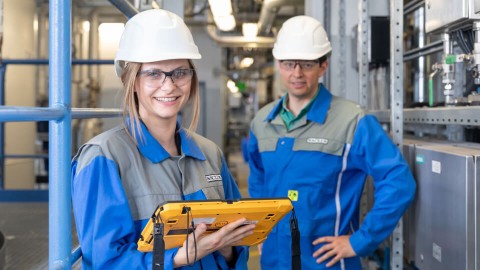VINNAPAS® EP 645

VINNAPAS® EP 645 is a specially modified vinyl acetate-ethylene (VAE) copolymer to offer excellent adhesion to a wide variety of difficult-to-bond substrates, the dispersion is poly (vinyl alcohol) stabilized for good wet tack, setting speed and excellent machinability.
Properties
VINNAPAS® EP 645 is produced without addition of plasticizers and can be used to produce adhesives that deliver bonding that remains permanently with flexibility and resistance to aging. VINNAPAS® EP 645 shows better adhesive and cohesive strength at elevated temperatures—a versatile balance that renders adhesives with very good heat resistance. And when plasticized, the heat resistance is less adversely affected than with other VINNAPAS® VAE copolymers.
VINNAPAS® EP 645 also shows high water resistance.
Data sheets
Properties
VINNAPAS® EP 645 is produced without addition of plasticizers and can be used to produce adhesives that deliver bonding that remains permanently with flexibility and resistance to aging. VINNAPAS® EP 645 shows better adhesive and cohesive strength at elevated temperatures—a versatile balance that renders adhesives with very good heat resistance. And when plasticized, the heat resistance is less adversely affected than with other VINNAPAS® VAE copolymers.
Application
The excellent flow properties and very high setting speed of VINNAPAS® EP 645 make it ideal as a co-blending dispersion for polyurethanes or other polymers in a variety of medium- to high-speed machine applications. Primary applications include synthetic leather market adhesive, between vinyl laminating and textile. VINNAPAS® EP 645 has been used successfully in synthetic leather adhesives for PVC sheet and textile or polyurethane sheet and textile, which benefits from its high cohesion strength.
If the product is used in applications other than those mentioned, the choice, processing and use of the product is the sole responsibility of the purchaser. All legal and other regulations must be complied with.
For questions concerning food contact status according the chapter 21 CFR (US FDA) and German BfR, please feel free to contact us.
Wacker Chemie AGGisela-Stein-Strasse 1
81671 Munich
Germany
Packaging
200 Kg Steel drum
220 Kg Steel drum
1 MT IBC
1.1 MT IBC
1 MT Returnable tote
Flexi bag.
Tank lorry
Storage
When the dispersion is stored in tanks, proper storage conditions must be maintained. The product has a shelf life of 9 months starting from the date of manufacture if stored in the original, unopened containers at temperatures between 5 and 30°C. Any longer periods for the maximum storage period that may be described in the Certificate of Analysis which accompanies each shipment of the product, take preference over this suggestion in which case the time period stated in the Certificate of Analysis shall be solely authoritative. Iron or galvanized-iron equipment and containers are not recommended because the dispersion is slightly acidic. Corrosion may result in discoloration of the dispersion or its blends when further processed. Therefore, the use of containers and equipment made of ceramics, rubberized or enameled materials, appropriately finished stainless steel, or plastic (e.g. rigid PVC, polyethylene or polyester resin) is recommended. As polymer dispersions may tend to superficial film formation, skins or lumps may form during storage or transportation. Filtration is therefore recommended prior to utilization of the product.
Preservation for Transport, Storage and further Processing
The product is adequately preserved during transportation and storage if kept in the original, unopened containers. However, if it is transferred to storage tanks, the dispersion should be protected against microbial attack by adding a suitable preservative package. Measures should also be taken to ensure cleanliness of the tanks and pipes. In unstirred tanks, a layer of preservative-containing water should be sprayed onto the surface of the dispersion to prevent the formation of unwanted skin and possible attack by microorganisms. The thickness of this water layer should be < 5 mm for low viscosity dispersions and up to 10-20 mm for high viscosity products. Proper procedures - periodic tank cleaning and sanitization - must be set up in order to prevent microbial attack. Contact your biocide representative/supplier for further plant hygiene recommendations. Measures should be taken to ensure that only clean air enters the tank when the dispersion is removed. Finished products manufactured from polymer dispersions usually also require preservation. The type and scope of preservation will depend on the raw materials used and the anticipated sources of contamination. The compatibility with other components and the efficacy of the preservative should always be tested in the respective formulation. Preservative manufacturers will be able to advise you about the type and dosage of preservative required. If the product is stored for a longer period, stirring is recomended before use.
VINNAPAS® EP 645 shows high viscosity at temperatures below 15°C. Therefore, we recommend to use VINNAPAS® EP 645 at room temperature
Sales and support
Allentown, PA 18106-9346
United States
+1 517 264-4088 (Fax)
How can we help you?
- Do you need help in choosing a product or do you require technical support? If so, please contact our experts.


